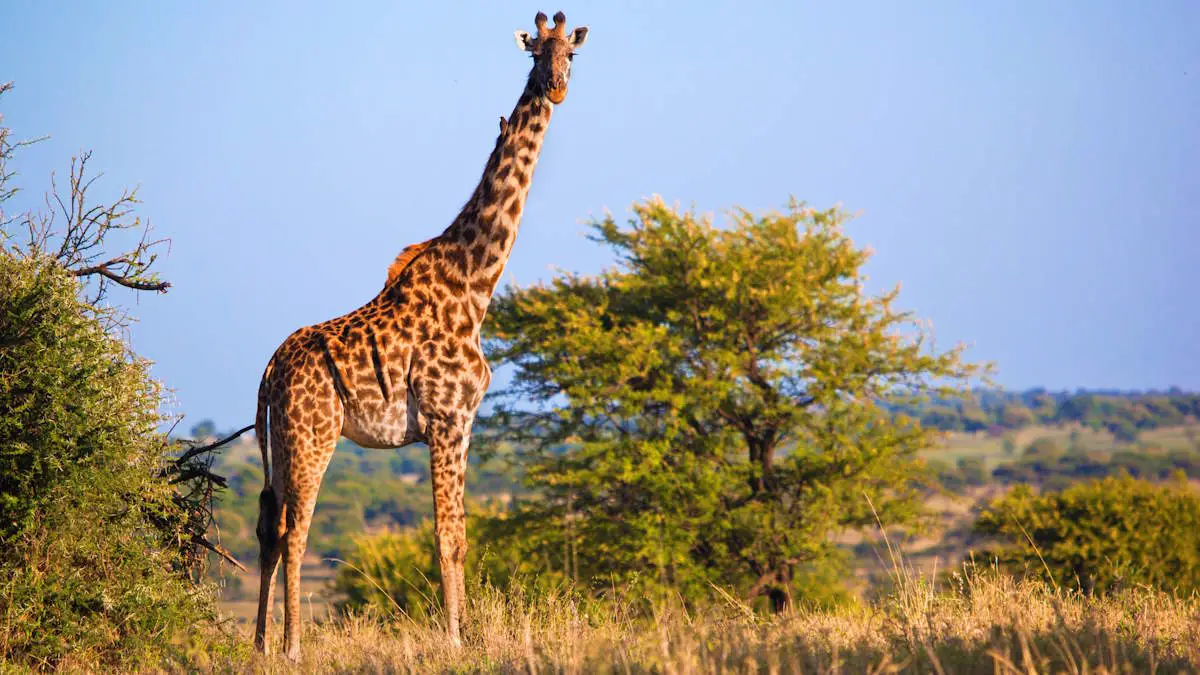Giraffes are like the tall towers of the animal world, living in Africa where it’s warm and grassy. They are famous for their long necks and spots, each one different like a fingerprint. Although they look quiet and calm, giraffes hide many surprises. They don’t just eat leaves and roam around; there’s much more to learn about them. From the way they drink water to how they talk without making a sound, giraffes are full of interesting secrets. We’re going to explore some of these cool facts, getting to know these tall friends better. Here are 10 amazing giraffe facts.
1. The giraffe is the tallest mammal in the world
A fully grown giraffe can stand 4.3-5.7 meters (14.1-18.7 feet) tall (see notes 1). Males are taller than females.
Even a newborn giraffe, which is about 1.7-2 meters (5.6-6.6 feet) tall is taller than most humans.
They are not so heavy for a 5-plus meter tall animal, thanks to their slim build. An average male weighs about 1,200 kg (2,645 lbs), while females are naturally lighter, about 800 kg (1,763 lbs).
Their height, combined with their big eyes and excellent eyesight, helps detect predators, such as lions and hyenas, from a distance.
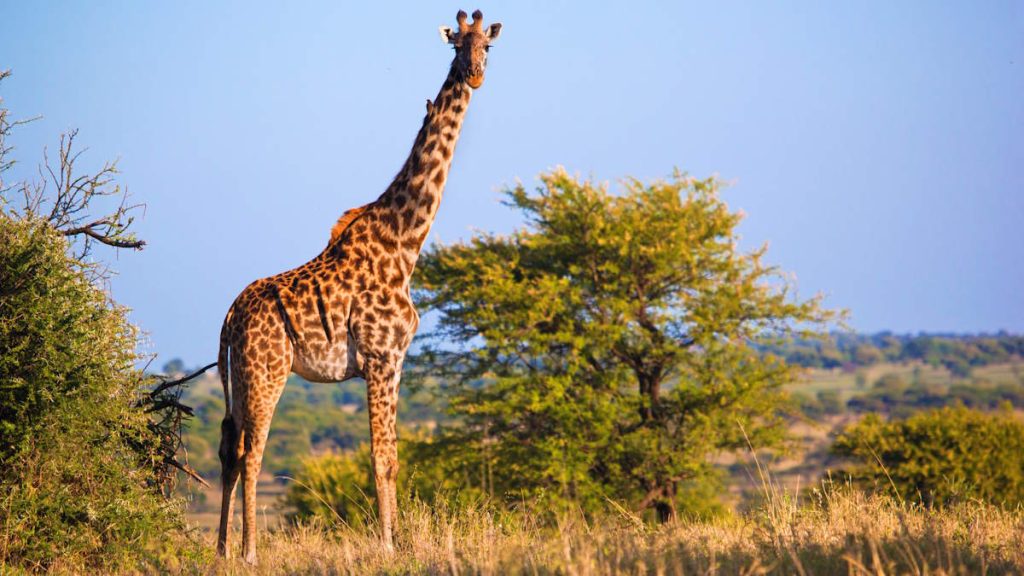
Giraffes usually inhabit savannahs and woodlands in Africa. Their coat pattern can serve as camouflage in the light and shade patterns of these environments.
They are herbivores and only eat plants. Their long height helps them reach the leaves and buds in the treetops.
Despite their long necks, giraffes have the same number of neck vertebrae as humans: just seven, but each one is super-sized, up to 10 inches long (25.4 cm).
They also have very long tongues (which grow to a whopping 53 cm or 21 inches!) that help them pull down leaves.
They spend most of their time eating, and can eat up to 45 kilograms (about 100 lbs) of leaves and twigs a day!
2. Giraffes require very little sleep, often getting by on just 30 minutes of sleep a day
Giraffes have one of the most intriguing sleep patterns in the animal kingdom. They’re among the shortest sleepers, clocking in just a few minutes at a time, which can add up to about 30 minutes per day. These brief naps are often taken standing up to keep them alert to the dangers of predators. When they do settle into a more vulnerable sleeping position, it’s an elegant sight- they fold their legs beneath them and twist their long necks around to rest their head on their hindquarters or lay it flat on the ground.
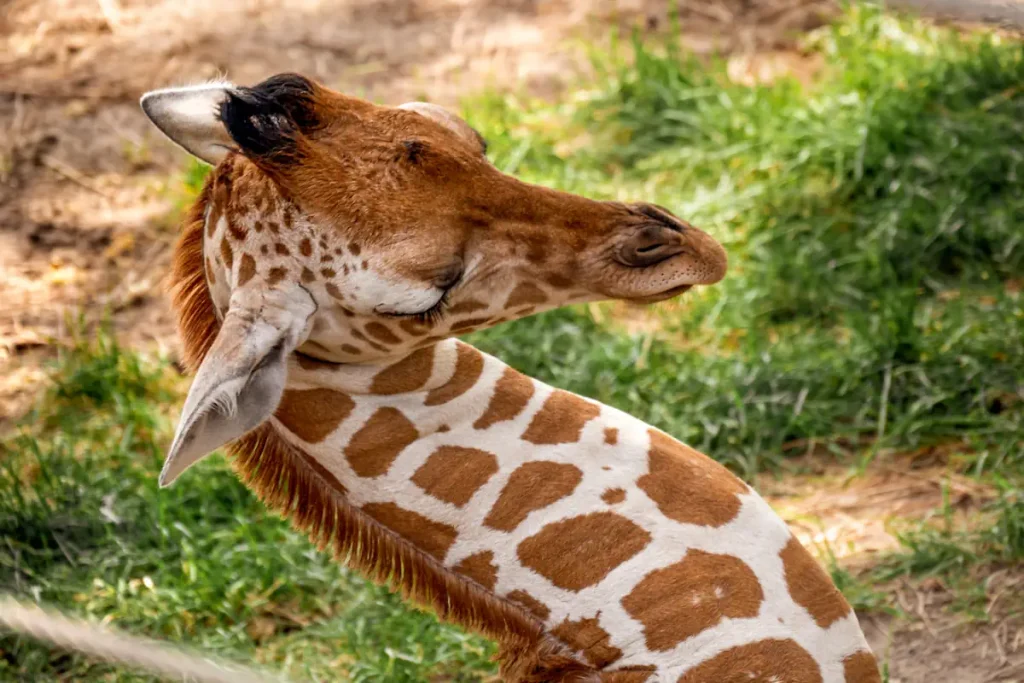
This power-napping lifestyle is a fascinating adaptation to their environment. Being so tall and visible, a deep, prolonged sleep could make them easy targets for lions and hyenas. Their ability to function on such minimal rest also speaks to the efficiency of their large brains, which presumably require less downtime to maintain optimal alertness.
Moreover, giraffes have the extraordinary ability to enter into short bouts of deep sleep while lying down, during which they experience rapid eye movement (REM) sleep. This is where dreaming happens, although it’s a mystery what a giraffe might dream about. Overall, the giraffe’s sleep strategy is a remarkable example of evolutionary adaptation, allowing them to remain the majestic sentinels of the savannah.

3. A giraffe’s neck is too short to reach the ground
Despite having the longest neck in the animal world, which can be up to 2.4 meters (7.9 feet) in length, they have also long legs, which are alone taller than many humans, about 1.8 meters or 6 feet. Combine this length with the body height, their neck is too short to reach the ground. To drink water, a giraffe first has to splay their forelegs and/or bend its knees. Only then they can lower their necks to reach the surface of the water to drink or eat grass (see the amazing video below).
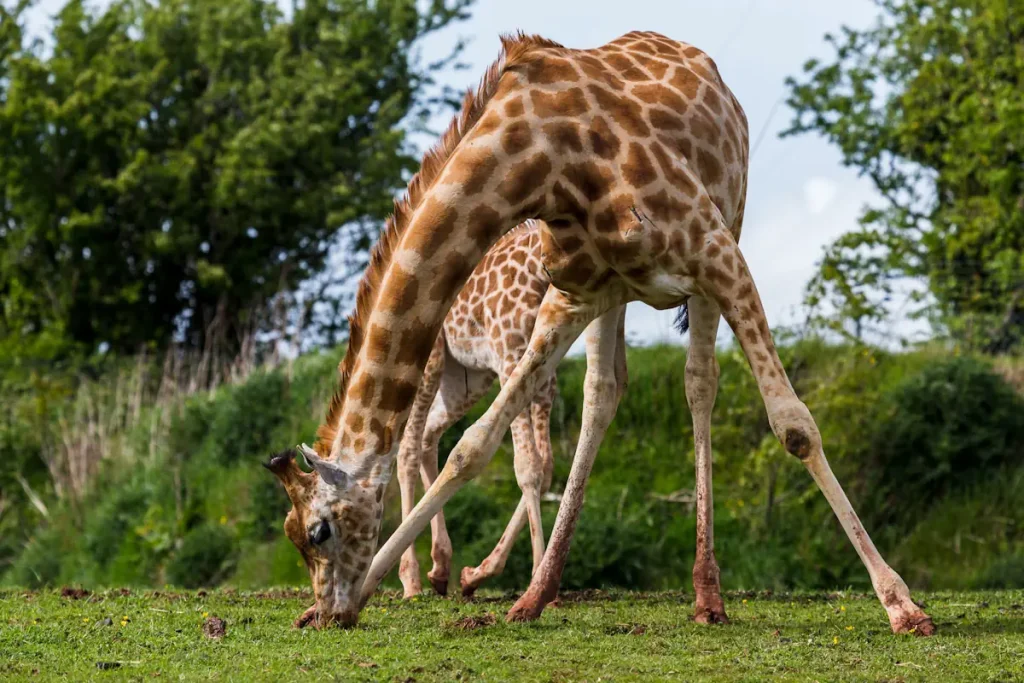
Fortunately for them, they only need to drink once every few days as most of their water comes from all the plants they eat.
Another amazing giraffe fact: to protect the animal’s brain from sudden changes in blood pressure when it lowers its head to drink, the jugular veins have incredibly elastic walls and large one-way valves that allow the veins to expand significantly and prevent the blood from flowing back to the brain.
Alternatively, to help fight gravity when the blood returns to the heart from the feet, their blood vessels are thickly walled and muscled, and the skin on the legs is so tight it acts like giant compression socks.
These unique adaptations have been studied by scientists at NASA to get inspiration for human space suits.
4. Female giraffes give birth standing up
The calf emerges head and front legs first. Giraffe calves grow quickly and can start running with their mothers just hours after birth – a necessary adaptation to avoid predators. Within a few hours of birth, the newborn is almost indistinguishable from a one-week-old calf, and they’re able to run with their mothers.
5. They hum at night
Giraffes are very quiet animals. It has been even suggested they don’t vocalize because they can’t generate enough airflow in their long necks, despite having well-developed larynx and laryngeal nerves. But, in 2015, a team of biologists recorded giraffes at three zoos humming at night, a vocalization they describe as “rich in harmonic structure, having a deep and sustained sound.” They published their findings in a study.
Scientists also think that humming giraffes might be communicating with each other.
6. They are very social animals
Giraffes are social animals and they roam in groups called a tower. A tower can contain up to 15 individuals. A male leads a tower.
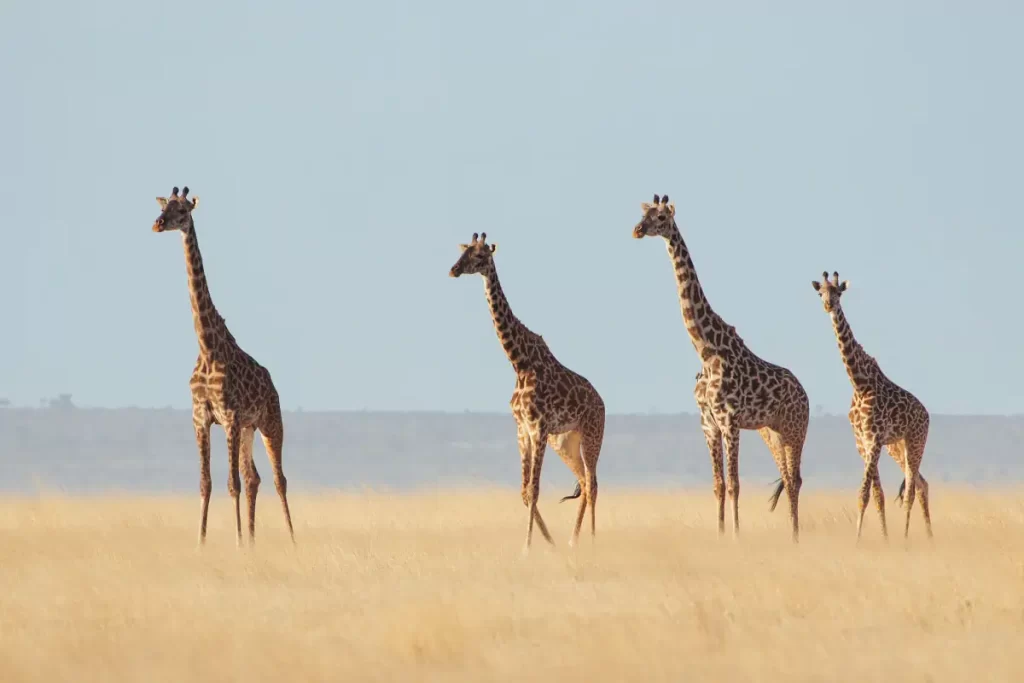
They live in loosely structured, fluid herds that can range from a few individuals to 20 or more. Unlike many other animal species, giraffes do not have strong social bonds, and the composition of their groups can change from day to day. This casual association is referred to as a ‘fusion-fission’ society, common among some primates and other mammals, where individuals may come and go as they please, joining a herd for a while before peeling off to join another.
The dynamics within a giraffe herd are quite subtle. They do not display the strict hierarchy that is characteristic of other animal groups, such as wolves or elephants. Instead, interactions are often peaceful and may be governed by kinship or the availability of food and mates. Giraffe herds are usually matriarchal, with females leading the group and their calves. Males tend to be more solitary or form bachelor groups, coming together with females only to mate.
Despite their quiet demeanor, giraffes are not mute. They communicate through a variety of sounds like moans, snores, hisses, and grunts, usually heard at night. Moreover, recent studies suggest that giraffes might communicate over long distances using infrasound – sounds that are too low for human ears to pick up.
While giraffes are social creatures, their interactions are not as intense or long-lasting as those seen in some other mammalian species. The fluid nature of their social structure is yet another facet of their adaptation to the vast and variable African savannah, where being too rooted in one place or group could be detrimental to survival. Their social system allows for flexibility, which is crucial in the ever-changing landscape they call home.
7. Males do “Neck fight”
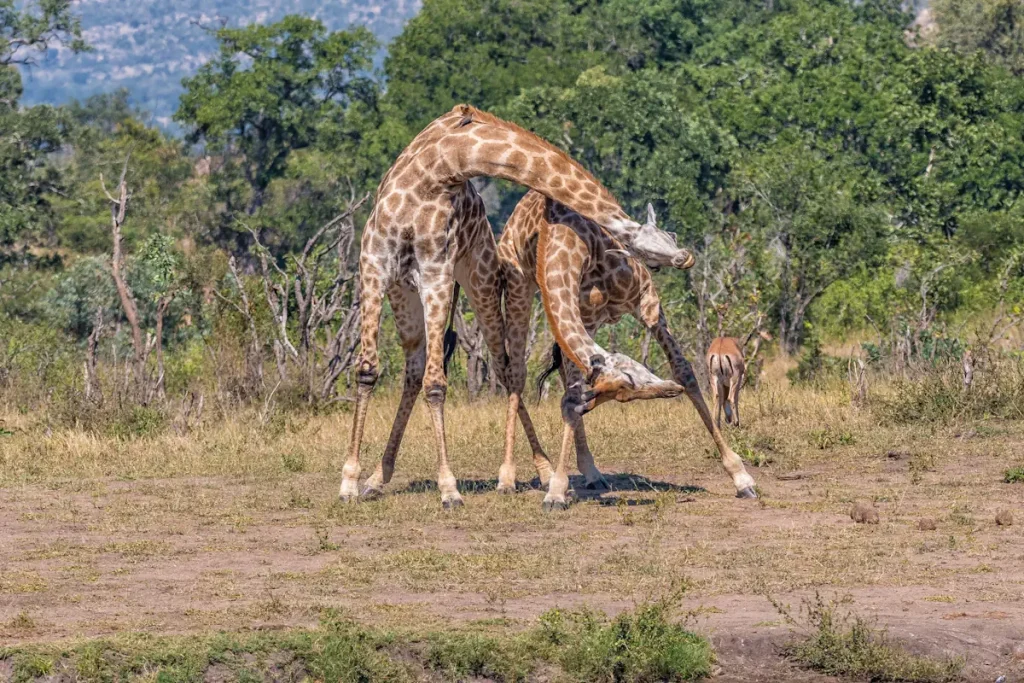
Giraffes utilize a very unusual battle technique. To display dominance, males (called bulls) fight by butting their long necks and heads against each other, called “necking”.
First, when they’re young, they playfully joust. Then, when they become mature males, the neck-to-neck battles become more e serious. Usually, these fights aren’t dangerous, These fights aren’t usually dangerous, and end when one bull admits defeat and just walks away. But, occasionally, and unfortunately, injuries, even deaths occur.
8. Compared to other animals, they have a longer lifespan
Giraffes have an unusually long lifespan compared to other wild animals, 25 years on average, but even up to 38 years. Because of their size, eyesight, and powerful kicks, adult individuals (especially larger ones) are usually not subject to predation. Although lions may regularly prey on individuals up to 550 kg (1,210 lb).
Captive individuals can live even longer, up to 40 years.
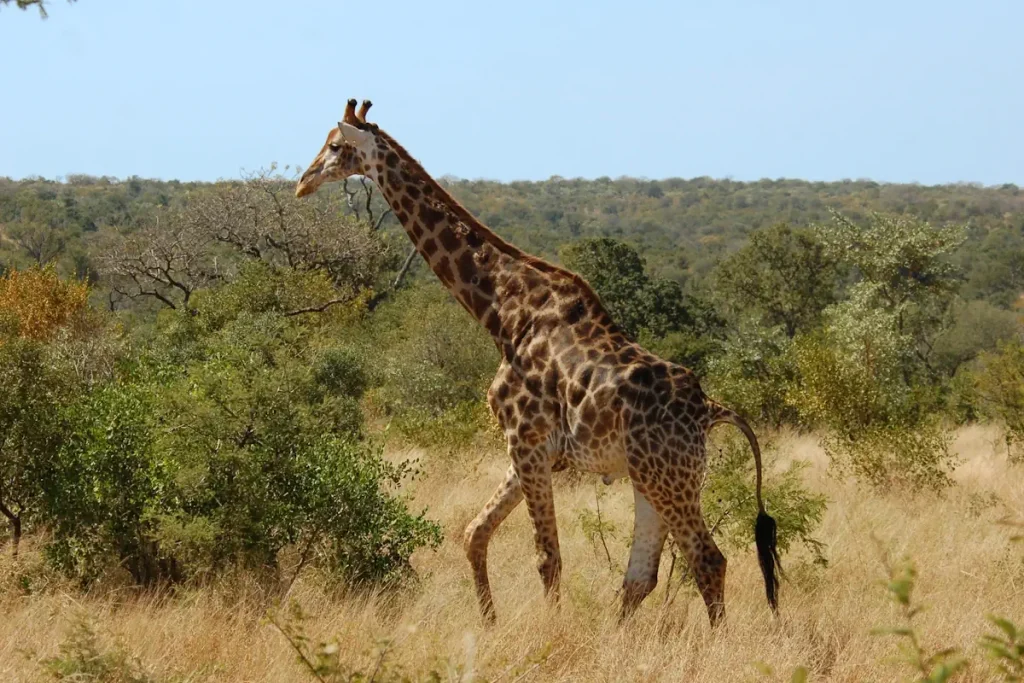
9. Their heart is big, powerful, and fast!
Their heart can weigh more than 11 kg (25 lb) and measures about 60 cm (2 feet) long. The wall of the heart can be as thick as 7.5 cm (3 inches). Giraffes have unusually high heart rates for their size, with an average resting heart rate of 40-90 beats per minute.
While running, their heartbeat can rise to 150 beats per minute. In general, almost as a rule, the larger the animal, the slower its heartbeats, and the smaller the animal, the faster its heartbeats. But, giraffes make an exception to this.
Interestingly, a giraffe’s blood pressure is twice that of an average human, which is essential to maintain blood flow to the brain against gravity.
10. Their feet are also big
Their feet are also large, about the size of a dinner plate with a diameter of 30 cm (1 foot – ironically).
Bonus giraffe fact 1: There’s a giraffe hotel in Kenya
There’s a five-star boutique hotel named Giraffe Manor in Kenya. It’s situated on private land in the indigenous forests of Nairobi, and it’s best known for the giraffes that walk around the hotel grounds. It’s common for them to peek inside the windows of various hotel areas, hoping to score a treat or two, before they head back to the forest.
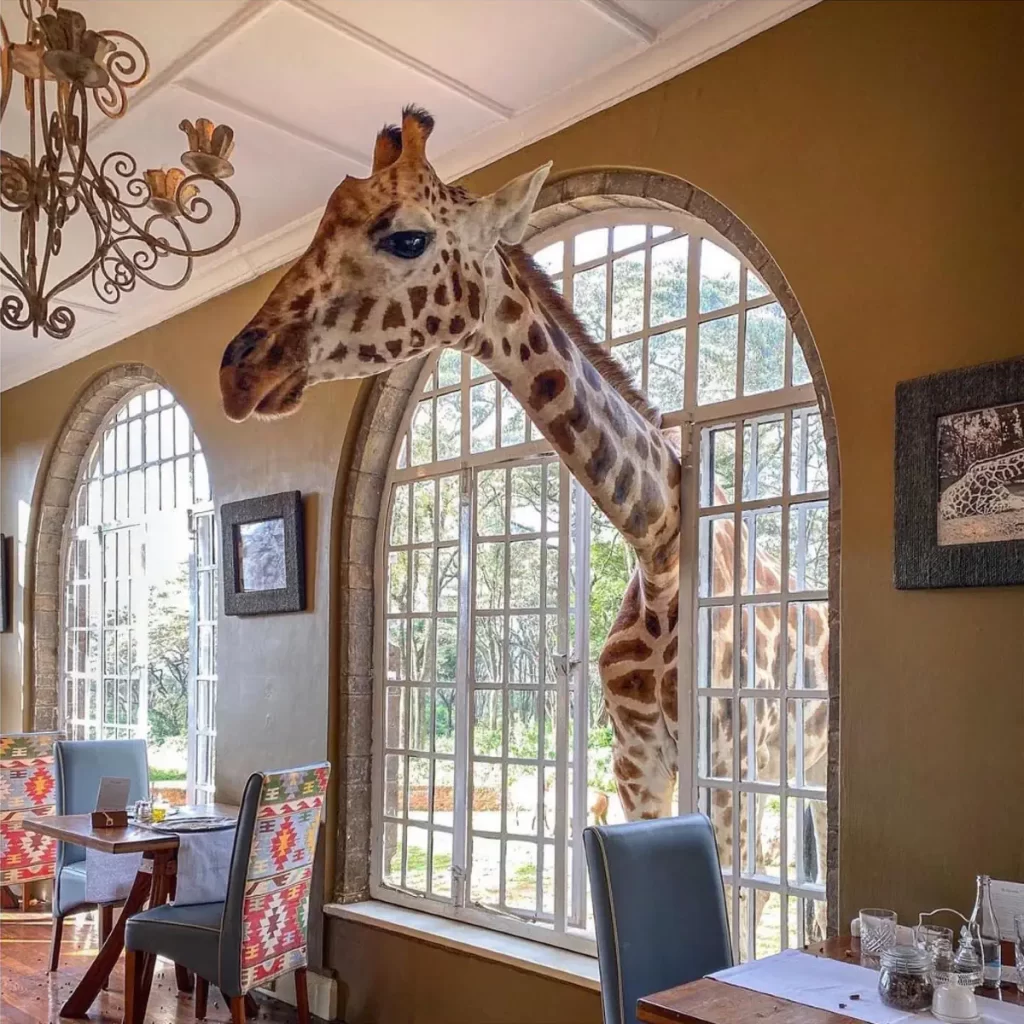
Bonus giraffe fact 2: They have a higher chance of getting struck by lightning
Yes, giraffes get struck by lightning more often than other (smaller/shorter) animals.
Some not-so-amazing giraffe facts
In 2016, giraffes were assessed as Vulnerable from a conservation perspective by the International Union for Conservation of Nature (IUCN).
For some subspecies (see notes 2), the situation is even more critical: Masai and reticulated subspecies are endangered, and the Rothschild subspecies are near threatened. The Nubian subspecies is critically endangered.
In 1985, it was estimated there were 155,000 giraffes in the wild. This declined to over 140,000 in 1999. Estimates as of 2016 indicate there are approximately 97,500 members of Giraffa in the wild. The primary causes for the decline of their numbers are habitat loss and direct killing for bushmeat markets.
In some populations, over 50% of all giraffe calves do not survive their first year.
Notes
1. Forest: The World’s Tallest Giraffe
According to the Guinness World Records, a 12-year-old giraffe called Forest, which is a resident of Australia Zoo in Queensland, has been confirmed as the world’s tallest giraffe, standing at 5.7 meters tall (18 ft 8 in). Guinness World Records article about Forest the Tallest Giraffe was written in July 2020, so Forest must be at least 13 years old (as of February 2022).
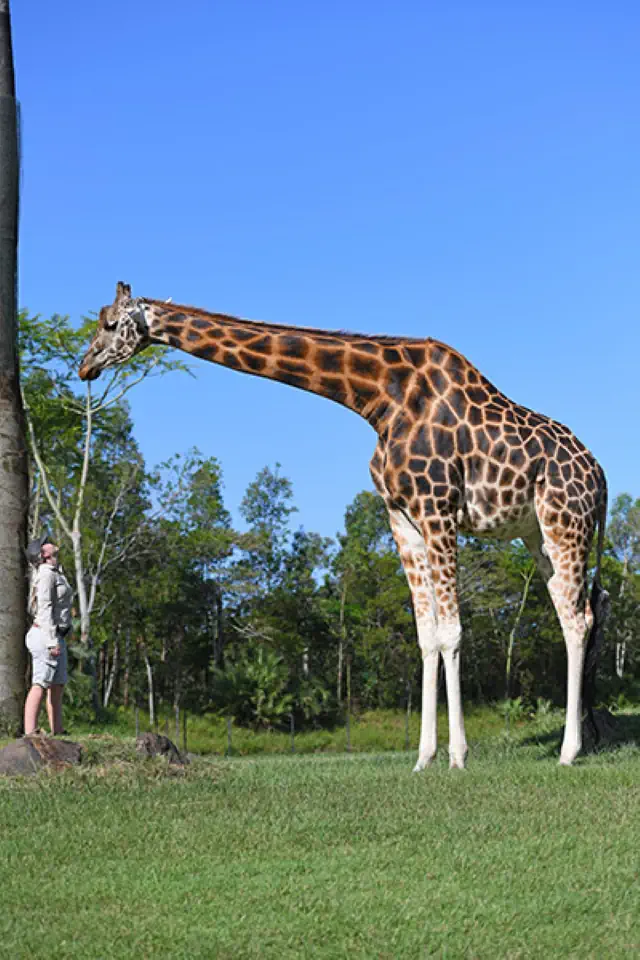
There are nine (or if you merge some of them, four) subspecies of giraffe.
- The Kordofan giraffe (G. c. antiquorum)
- The Nubian giraffe (G. c. camelopardalis)
- Rothschild’s giraffe (G. c. rothschildi)
- The West African giraffe (G. c. peralta)
- The reticulated giraffe (G. c. reticulata)
- The Angolan giraffe (G. c. angolensis)
- The South African giraffe (G. c. giraffa)
- The Masai giraffe (G. c. tippelskirchi)
- Thornicroft’s giraffe (G. c. thornicrofti)
Or, the merged list is:
- Northern giraffe (G. camelopardalis) (1, 2, 3, and 4 merged)
- Reticulated giraffe (G. reticulata)
- Southern giraffe (G. giraffa) (6 and 7 merged)
- Masai giraffe (G. tippelskirchi) (8 and 9 merged)
Sources
- “Facts About Giraffe – Giraffe Facts from Experts” on the Giraffe Conservation website
- 10 Giraffe Facts on the National Geographic Kids website
- Giraffe on Wikipedia
- Why Do Giraffes Hum at Night? on the Tree Hugger website
- How Many Elephants are Left in the World in 2025? - August 17, 2025
- Moon Landings: All-Time List [1966-2025] - February 2, 2025
- What Is Max-Q and Why Is It Important During Rocket Launches? - January 16, 2025
